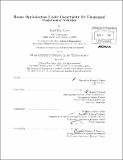| dc.contributor.advisor | Patrick Jaillet. | en_US |
| dc.contributor.author | Cates, Jacob Roy | en_US |
| dc.contributor.other | Massachusetts Institute of Technology. Operations Research Center. | en_US |
| dc.date.accessioned | 2011-12-19T18:49:22Z | |
| dc.date.available | 2011-12-19T18:49:22Z | |
| dc.date.copyright | 2011 | en_US |
| dc.date.issued | 2011 | en_US |
| dc.identifier.uri | http://hdl.handle.net/1721.1/67771 | |
| dc.description | Thesis (S.M.)--Massachusetts Institute of Technology, Sloan School of Management, Operations Research Center, 2011. | en_US |
| dc.description | Cataloged from PDF version of thesis. | en_US |
| dc.description | Includes bibliographical references (p. 87). | en_US |
| dc.description.abstract | As our technology continues to increase, our military wishes to reduce the risk service members endure by using unmanned vehicles. These unmanned vehicles will, over time, become more independent and trustworthy in our operational military. The goal of this thesis is to improve the intelligence an unmanned vehicle has in its decision making to keep up with ever increasing capabilities. In this thesis, we assume an Unmanned Underwater Vehicle (UUV) is given tasks and must decide which ones to perform (or not perform) in which order. If there is enough time and energy to perform all of the tasks, then the UUV only needs to solve a traveling salesman problem to find the best order. We focus on a tightly constrained situation, where the UUV must choose which tasks to perform to collect the highest reward. In prize collecting traveling salesman problems, authors are often dismissive about stochastic problem parameters, and are satisfied with using expected value of random variables. In this thesis a more rigorous probabilistic model is formulated which establishes a guaranteed confidence level for the probability the UUV breaks mission critical time and energy constraints. The formulation developed takes the stochasticity of the problem parameters into account and produces solutions which are robust. The thesis first presents a linear programming problem which calculates the transition probabilities for a specific route. This linear programming problem is then used to create a constraint which forces the UUV to choose a route that maintains an appropriate confidence level for satisfying the time and energy constraints. Once the exact model is created, heuristics are discussed and analyzed. The heuristics are designed to provide "good"' solutions for larger sized problems and maintain a relatively low run time. | en_US |
| dc.description.statementofresponsibility | by Jacob Roy Cates. | en_US |
| dc.format.extent | 87 p. | en_US |
| dc.language.iso | eng | en_US |
| dc.publisher | Massachusetts Institute of Technology | en_US |
| dc.rights | M.I.T. theses are protected by
copyright. They may be viewed from this source for any purpose, but
reproduction or distribution in any format is prohibited without written
permission. See provided URL for inquiries about permission. | en_US |
| dc.rights.uri | http://dspace.mit.edu/handle/1721.1/7582 | en_US |
| dc.subject | Operations Research Center. | en_US |
| dc.title | Route optimization under uncertainty for Unmanned Underwater Vehicles | en_US |
| dc.title.alternative | Route optimization under uncertainty for UUVs | en_US |
| dc.type | Thesis | en_US |
| dc.description.degree | S.M. | en_US |
| dc.contributor.department | Massachusetts Institute of Technology. Operations Research Center | |
| dc.contributor.department | Sloan School of Management | |
| dc.identifier.oclc | 767528290 | en_US |
